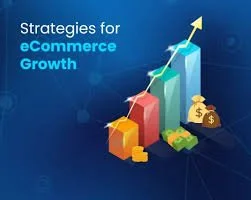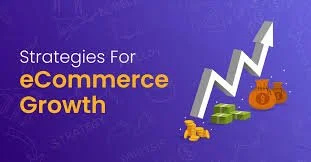7 Growth Marketing Tactics for eCommerce Stores to Consider
7 Growth Marketing Tactics for eCommerce Stores to Consider in 2025
eCommerce has swept the shopping scene. According to Statistica, eCommerce accounted for nearly 20% of retail sales worldwide in 2021. Estimates indicate that by 2025, these online stores will account for almost a quarter of total retail sales worldwide.
A significant factor in the growth of this online shopping modality was the COVID-19 pandemic. As individuals stayed home to avoid the virus, people turned their attention to online shopping. Census Bureau reported that ‘eCommerce sales increased by $244.2 billion or 43% in 2020, the first year of the pandemic, rising from $571.2 billion in 2019 to $815.4 billion in 2020.’
As the number of eCommerce stores has risen, the need to stand out against competitors has also increased. Considering that the eCommerce experience is virtual, growth marketing strategies are crucial to setting your brand apart from others
The Case for Growth Marketing in eCommerce
Growth. It’s something every online store wants. And with the global eCommerce pie continuing to grow, everyone wants their own slice. When you look at estimated revenues for 2022 – $875 billion in the US alone, you can understand why.
Of course, everyone and their dog wants to be part of that eCommerce market. There are up to 24 million e-commerce sites globally, though many of them are small businesses. Even small businesses contribute to an extremely competitive market, meaning you need to get things right.
Whether you’re an established retailer or just starting out on your eCommerce journey, you’ll want to grow that business. What growth strategies can you employ? We look at a few growth-hacking tips to help you take your eCommerce business to the next level.
What does Growth Marketing Entail for eCommerce
There’s more to growth in the eCommmerce sector than simply size and revenue. You could compare eCommerce growth to chess; you should always be looking more than one move ahead to see how an individual tactic will affect different areas.
Growing your business is about long-term vision and results. That means, not only looking at basic metrics such as your conversion rate, but also at the bigger picture of customer acquisition, retention, and long-term loyalty. Customer satisfaction is also the foundation of both success and future growth.
Growth marketing was born out of necessity for startups and SaaS companies whose needs couldn’t be covered by traditional marketing. Building brand awareness and encouraging audience engagement are not enough for any startup to grow fast. On the contrary, A/B testing and establishing certain growth metrics were closer to what they needed. Growth marketing, in the way that it operates, came to fill that void.
Likewise, growth marketers, possess a unique skill set that combines engineering and marketing. Whereas traditional digital marketers focus on awareness and customer acquisition, growth marketers go beyond that. Growth marketers use a different framework. According to this, marketing goes beyond acquisition and has 5 phases:
Acquisition
Activation
Retention
Referral
Revenue
In short, growth hacking, when compared to digital marketing, is more technical, it has a certain process, and it requires a different skill set. And it includes more aspects like customer retention.
While it is true that growth marketing has its roots in SaaS, it has gone beyond that. eCommerce in reality is closer to retail than to SaaS. However, despite this, growth marketing has actually been a boon for a number of commercial brands, such as Dollar Shave Club and Gymshark, just to name a couple.
But before we delve into what differentiates eCommerce and SaaS, a true understanding of growth marketing in general, as well as how it pertains to eCommerce is needed.
What is Growth Marketing?:
Growth marketing is a long-term, strategic methodology that works to help brands achieve sustainable, measurable growth. It is a holistic and data-driven approach that leverages end-to-end funnel optimization to find, attract, convert, retain, and grow buyers into loyal brand advocates and evangelists.
However, it is worth noting that just because growth marketing is holistic, it is worth noting that in order to be effective that there are a number of tactics that need to be layered in order to get the data needed to learn in order to leverage growth. It takes the traditional marketing model and adds layers such as A/B testing, value-additive blog posts, data-driven email marketing campaigns, SEO optimization, creative ad copy, and technical analysis of every aspect of a user’s experience. The insights gained from these strategies are quickly implemented in order to achieve robust and sustainable growth.
As mentioned, growth marketing goes way beyond the approach of traditional marketing by attracting users, engaging them (ex; with content), getting them to become members or try your services or make a purchase, getting them to keep their subscription or make another purchase, and ultimately if all goes well, getting them to make a testimonial or in other ways become a brand ambassador or champion of your brand.
So in a nutshell, growth marketing is an evidence-based approach that centers around focusing on the entire business process or customer journey in order to achieve sustainable business growth.
The impact of growth marketing your eCommerce store
If you’re looking to make a living from your eCommerce store, there’s only one thing to have in mind: growth, growth, growth. Growth involves increasing your revenue and average order value and attracting more customers to your store.
Once you’ve got to a certain number of consistent orders, you can start hiring more staff to take on roles, and even extend your offerings to other countries. Having a wider team around you frees up your time to further increase eCommerce sales, or even start another business to supplement your income.
However, beyond certain factors that inherently come with growth in your business, there are a few things that must be present for both a growth-marketing framework and a growth-marketing mindset to set into your eCommerce business.
A Marketing-Centric Focus: More and more people shop online these days, with more than 2.14 billion people shopping online in 2021. That’s great news for you – but great news for your competitors too.
The more people turn online to look for products, the more you have to differentiate yourself from your competitors, which can be easier said than done. What you need is a killer marketing strategy. Later in this article, we will focus on tactics for an effective growth-marketing strategy tailored to eCommerce businesses.
2. Social Media as a Driver in One Form or Another: The most effective way to take advantage of social media’s power is to create a social media strategy that fits neatly into your overall marketing campaign. If you have an upcoming sale and you’re sending emails and posting blogs about it, complement your efforts by posting about it on social media. User-generated content marketing provides an excellent form of social proof. After all, it makes sense that consumers are more likely to trust your products when other consumers vouch for them.
3) Invest Time and Money in Analytics to Spur Growth: In the world of business, every mistake can be turned into a lesson for the future. When you try a new technique in a marketing campaign or invest in an app that doesn’t work as well as you’d hoped, don’t beat yourself up. The only way you’ll ever continually improve is by learning from previous mistakes and using them to inform your future strategies.
Another way to learn from the past is with analytics. There are plenty of ways to analyze the performance of marketing campaigns and the like. Depending on the email provider you use, for example, you can check click-through and open rates for your emails to check which subject lines perform well, and which perform not so well.
4) Investing in Customer Service: If customers come to your store and experience poor customer service, they’ll make sure people know about it. The negative impact that poor feedback can have on your store shouldn’t be underestimated.
From negative reviews to word-of-mouth complaints, one bad interaction can cost you thousands. If you’ve ever had a poor customer service experience you’ll know that it puts you off returning to a particular store or service provider.
With that in mind, excellent customer service is non-negotiable for any eCommerce business that’s serious about growth. But with so many tasks for an eCommerce business owner to juggle, how do you find time to provide excellent customer service at the same time as creating foolproof marketing strategies, and building relationships with suppliers? Now there are many options for this, including chatbots, customer service software, and more that can help with the process. While there are many possibilities that are worth exploring for your business, for the purposes of this article, it is worth just emphasizing the importance of making sure customer service is invested not just in terms of technical resources, but also in terms of human capital and more importantly time.
5) On a Related Note, Make Sure Existing Customers are a Priority: Don’t forget that growth can also be attained simply by keeping your existing customers – and this includes turning around disengaged customers. By increasing the order value of every customer, you can increase your profits without having to attract significant numbers of new customers. Retaining customers can become more important than appealing to new ones.
Existing customers can become a crucial part of your marketing strategy, too. Happy customers are a free method of marketing that not enough businesses consider because they provide social proof and recommend your store to friends and family members, increasing your number of sales with word of mouth alone.


